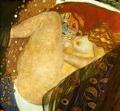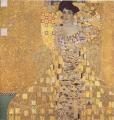Published: March 5, 2012
Art Deco (Art Deco, Art Deco)    - Art Deco style became popular in the 1918-1939 years. France, partly in other European countries and the USA. The impetus for the rapid development of this style was the Paris Exhibition of 1925, which displayed the latest advances in architecture, interior design, furniture, metal, glass and ceramics. For this exhibition, the famous French architect Le Corbusier, one of the founders of constructivism and functionalism, designed and built the pavilion "Esprit Nouveau" (French «Esprit Nouveau» - «The New Spirit"), a famous artist R. Lalique - a fountain of colored glass with light effects and the "glass interior" pavilion of the Sevres porcelain factory. If the architect Le Corbusier his work marked a departure from the ideas of constructivism, later dubbed the "neoplastitsizma", then the jeweler R. Lalique - the evolution of the whimsically curved lines and styling of Art Nouveau florealnyh to a simple geometric forms. In general style of «Art Deco» can be seen as the last stage of the development of art Nouveau period, or as a transitional style from modern to post-war functionalism, design, "International Style". In art, Art Deco continued his favorite themes and motifs of modernity - precisely the style of Art Nouveau - sinuous line, an unusual combination of expensive and exotic materials, images of fantastic creatures, waveform, shells, dragons, peacocks, swan necks and pale, languid women with flowing hair. In all felt some fatigue, satiation, but other than that, and longing for the use of geometric shapes: angles and lines, circles and broad planes of pure color. These qualities distinguish the interiors, designed by Jean Delamare projects, architectural designs R. Mallet-Stevens, jewelry artists of the Paris firm of Cartier. - Art Deco style became popular in the 1918-1939 years. France, partly in other European countries and the USA. The impetus for the rapid development of this style was the Paris Exhibition of 1925, which displayed the latest advances in architecture, interior design, furniture, metal, glass and ceramics. For this exhibition, the famous French architect Le Corbusier, one of the founders of constructivism and functionalism, designed and built the pavilion "Esprit Nouveau" (French «Esprit Nouveau» - «The New Spirit"), a famous artist R. Lalique - a fountain of colored glass with light effects and the "glass interior" pavilion of the Sevres porcelain factory. If the architect Le Corbusier his work marked a departure from the ideas of constructivism, later dubbed the "neoplastitsizma", then the jeweler R. Lalique - the evolution of the whimsically curved lines and styling of Art Nouveau florealnyh to a simple geometric forms. In general style of «Art Deco» can be seen as the last stage of the development of art Nouveau period, or as a transitional style from modern to post-war functionalism, design, "International Style". In art, Art Deco continued his favorite themes and motifs of modernity - precisely the style of Art Nouveau - sinuous line, an unusual combination of expensive and exotic materials, images of fantastic creatures, waveform, shells, dragons, peacocks, swan necks and pale, languid women with flowing hair. In all felt some fatigue, satiation, but other than that, and longing for the use of geometric shapes: angles and lines, circles and broad planes of pure color. These qualities distinguish the interiors, designed by Jean Delamare projects, architectural designs R. Mallet-Stevens, jewelry artists of the Paris firm of Cartier. From Art Nouveau boundary XIX-XX centuries, the Art Deco style combines and the desire of many artists (performing the will of the wealthy customers) to create the illusion of prosperity and "luxurious life" in the difficult years of the "lost generation" between the two world wars. This was the last "smart style" of the European capitals, consciously oriented to the past. The spiritual bewilderment and confusion of aesthetic criteria, as if heralding the horrors of the Second World War and the emptiness of the first postwar years, overshadowed by a conscious, eclectic retro program. In the course went Empire elements, Egyptian and Archaic Cretan-Mycenaean art, combined findings decorators Russian Ballet Seasons in Paris, Post-Impressionist painters, the Expressionists, Surrealists with forms of Eastern, Japanese, Chinese and primitive African art. Opening of art Amar-HN, the tomb of Egyptian pharaoh Tut-jamon (1922), provided by the tastes of the people as a strong influence, as well as sleek modern locomotives and cars. The interiors are designed in the style of Art Deco, the impression is not the composition and amount of individual components, grouping "trendy things" - furniture, textiles, bronzes, glass, ceramics. Not accidentally, many of the interior called "Collector's Pavilion", "painter's studio." These interiors are created with "glamor" of the 1920s, expensive hotels and restaurants and because of their style sometimes called "the style of the Ritz" (English Ritz Style). Significantly, the first exhibition of surrealist painters in Paris in the same 1925 in the Art Deco decorative paintings and re-entered the fashion stained glass and mosaics depicting women "perverted figure" in the expressionist movement fractured, deformed - with fantastically advanced "male" muscle. All this is indicative of a crisis of taste. In the "era of the lost generation" is especially prized expensive exotic materials: ivory, black - ebony, pearls, diamonds, shagreen leather, even the "lizard skin" and the crocodile. In the late forms of Art Deco style comes close to the geometric constructivism. No wonder believe that designers Art Deco - the heirs of the Viennese school of architecture - have shaped the program of German Bauhaus (see also "Vienna Workshops"). In Italy and Germany, elements of style Art Deco, connecting with the forms of Neoclassicism, grew into the architecture of the "new empire" - the Nazi Third Reich style. Art Deco was influenced by French artists of Baccarat glass factory and the English ceramic workshop Daulton. The same style is referred sometimes naive painter R. Dufy. The most famous artists of the French Art Deco: J. De Lamar, M. Dufresne, J. Kotera, R. Lalique, P. Legrain, P. Iribe, Zak, Clarice K., R. Mallet-Stevens, A. Martin , J. Prouv?, P. Poiret, J. Pyuiforka, A. Rato, ZH.-E. Ruhl-mann, L. Xu, R. Erte, P. Jan?k. Art Deco is called "the last of artistic styles," connect the unconnected. Maybe just that he has had a significant influence on the further development of many forms of art. In the 1930-1950-ies, and note the existence of a "Soviet Art Deco». Some notable examples are the work of sculptors N. Danko, I. Efimov, V. Mukhina - works of porcelain, metal, glass and unusual for that time, generalization and geometrization of forms, as well as "lush, causing a decorative printed cotton fabrics", decorated, Nevertheless, the Soviet propaganda attributes (see "propaganda art"; socialist realism). At the end of the XX century bold contrasts generalized and geometrized shapes and bright colors, open style of Art Deco, revived in the design and fashion, and interior design, jewelry, clothing, advertising graphics
By JenKiriakos, 2328 Views

-
Hide Comments (0)
Similar articles:
|